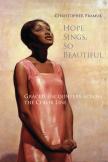Across Great Divides
As everyone was scrambling for information after the bombing at the Boston Marathon, CNN announced that “a dark-skinned individual” was seen leaving the area. Recently, in an article on wealth in the United States, The New York Times reported that white families are about six times as wealthy as black and Hispanic families. There is a color line. It divides people and is an obstacle to social justice. Christopher Pramuk, a theology professor at Xavier University in Cincinnati, invites us to face the complexities of race in the United States with truthfulness and hope.
In Hope Sings, So Beautiful, Pramuk expresses hope’s power to resist the polarizing rhetoric that so often imprisons discussions of race and invites fresh thinking and fruitful dialogue in the face of it.
This book, well written and deep, is spiritual reading. It engages one’s spirit and calls the reader to reflection and meditation. Drawing on the writings of a variety of poets and theologians, the author raises up a “most daring and revolutionary concept… God is love” as the foundation for a spirituality on the ground that crosses race lines and social locations and facilitates insight into worlds hidden from provincial and conventional thought. Awareness of God helps us guard against the “constant threat of error” that can turn a person’s limited perspective into an idol or a prison.
The book amplifies the tensions of human experience and reflects on them theologically. Christ’s body is both united and broken. While Jesus heals blindness, he does not spare us the tension of experiencing the process. Though everyone stands in a social location, we can visit and be marked by other similar locations. Pramuk admits: “Whiteness is and is not my point of entry.” He and his wife adopted two children from Haiti, and he says, “The color line passes right through our family.” The problem of racial justice is more personal when you have some “skin in the game.” In many ways, he draws our attention to the flesh and blood reality of the incarnation. The children of adoption are transformed and transforming.
Pramuk introduces us to women and men of vision and imagination. We meet Etty Hillesum, a young Jewish woman murdered at Auschwitz whose diaries reveal God in images of warmth, fleshiness and femininity. Pramuk fuses a connection between the poetry of Thomas Merton and the lyrics of Stevie Wonder that take us out of our comfort zones into suffering and the hope of a world made new. Both resist commodification and alienation and call us to human solidarity.
M. Shawn Copeland’s story of a Somali woman, taunted by a crowd as she gave birth to a child unassisted along the side of a road in Italy, reminds us of Christ who was taunted as he carried the cross and drew this woman and all despised bodies to himself. Billie Holiday’s song “Strange Fruit” pushes the margins of white consciousness and links the realities of lynching and crucifixion. Between Good Friday and Easter, the first disciples experienced the crucifixion as lynching, a scandal of senseless suffering and death. The religious imagination bears hope where despair is warranted, but it is not fantasy that is untethered to history, memory and experience.
Where do we stand today? Hurri-cane Katrina continues to stand out as evidence that the color line remains. The privileged white barkers of the airwaves clutched it as they took an opportunity to kick the vulnerable and charge that they were at fault for the problems of New Orleans and of race itself. The problem of racism in the United States is not only a black or brown problem arising from destructive behaviors in the ghetto but a crisis woven into the very fabric of civilization.
Citing Dr. Martin Luther King Jr. and the African-American theologian Howard Thurman, Pramuk reminds us that the movement toward racial justice and integration is a spiritual movement rooted in a biblical vision of the dignity of all life within the “interrelated structure of all reality.”
So how do we respond? Radical problems require radical responses. In conversation with Pramuk, William Hart McNichols, a priest and iconographer who lives outside of Taos, N.M., reminds us that the Western mind investigates and analyzes, but the Indian mind sits in and with mystery. Perhaps we are called to do what Jesus did—“wait in the quietness for some centering moment that will redefine, reshape and refocus our lives.” Pramuk offers the witness of his own radical and prophetic efforts to create cross-racial solidarity in a racist culture by building a multiracial family.
Thea Bowman, F.S.P.A., believed Catholicism had the power to forge empathetic relationships across the color line. This is not work left to individuals; it takes a church. How can the church make it more possible for people to cross the color line? The spirit of Catholic Action, “see, judge, act,” is relevant here.
The first step is repentance. We have maintained segregated parish boundaries. In conversations about parish and diocesan reorganization today, is racial solidarity a consideration? Pramuk reminds us that the church is “called to a radically inclusive way of being in the world because of who God is!” St. Francis heard the command, “Repair my church.” How do we repair the structures of church and society to help people move beyond racist behaviors? Pramuk suggests that in this regard we suffer from a poverty of imagination. The quest for racial solidarity needs to be pursued in thought, word and deed.
This article also appeared in print, under the headline “Across Great Divides,” in the July 29-August 5, 2013 , issue.








